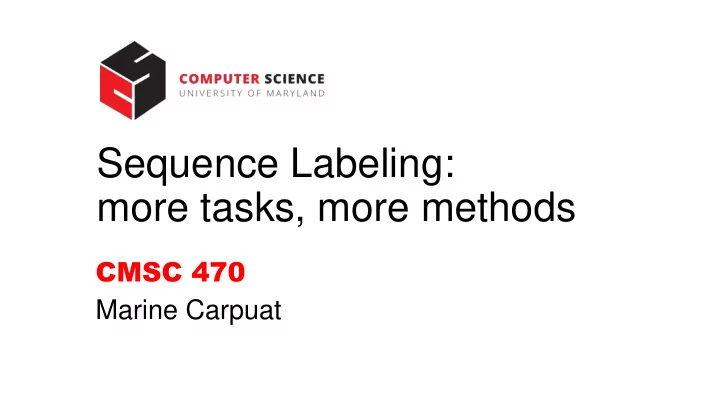

Sequence Labeling: more tasks, more methods CMSC 470 Marine Carpuat
Recap: We know how to perform POS tagging with structured perceptron • An example of sequence labeling tasks • Requires a predefined set of POS tags • Penn Treebank commonly used for English • Encodes some distinctions and not others • Given annotated examples, we can address sequence labeling with multiclass perceptron • but computing the argmax naively is expensive • constraints on the feature definition make efficient algorithms possible • Viterbi algorithm for unary and markov features
Sequence labeling tasks Beyond POS tagging
Many NLP tasks can be framed as sequence labeling • Information Extraction: detecting named entities • E.g., names of people, organizations, locations “ Brendan Iribe, a co-founder of Oculus VR and a prominent University of Maryland donor, is leaving Facebook four years after it purchased his company .” http://www.dbknews.com/2018/10/24/brendan-iribe-facebook-leaves-oculus-vr-umd-computer- science/
Many NLP tasks can be framed as sequence labeling x = [Brendan, Iribe , “,”, a, co -founder, of, Oculus, VR, and, a, prominent, University, of, Maryland, donor, “,”, is, leaving, Facebook, four, years, after, it, purchased, his, company, “.”] y = [B-PER, I-PER, O, O, O, O, B-ORG, I-ORG, O, O, O,B-ORG, I-ORG, I- ORG, O, O, O,B-ORG, O, O, O, O, O, O, O, O] “BIO” labeling scheme for named entity recognition
Many NLP tasks can be framed as sequence labeling • The same kind of BIO scheme can be used to tag other spans of text • Syntactic analysis: detecting noun phrase and verb phrases • Semantic roles: detecting semantic roles (who did what to whom)
Many NLP tasks can be framed as sequence labeling • Other sequence labeling tasks • Language identification in code-switched text “ Ulikuwa ukiongea a lot of nonsense. ” ( Swahili/English) • Metaphor detection “he swam in a sea of diamonds” “authority is a chair , it needs legs to stand ” “in Washington, people change dance partners frequently, but not the dance” • …
Other algorithms for solving the argmax problem
Structured perceptron can be used for other structures than sequences • The Viterbi algorithm we’ve seen is specific to sequences • Other argmax algorithms necessary for other structures (e.g. trees) • Integer Linear Programming provides a general framework for solving the argmax problem
Argmax problem as an Integer Linear Program • An integer linear program (ILP) is an optimization problem of the form • For a fixed vector a • Example of integer constraint: • Well-engineered solvers exist • e.g, Gurobi • Useful for prototyping • But general not as efficient as dynamic programming
Casting sequence labeling with Markov features as an ILP • Step 1: Define variables z as binary indicator variables which encode an output sequence y • Step 2: Construct the linear objective function
Casting sequence labeling with Markov features as an ILP • Step 3: Define constraints to ensure a well-formed solution • Z’s should be binary: for all l, k’, k • For a given position l, there is exactly one active z • The z’s are internally consistent
Loss-augmented structured prediction
In default structured perceptron, all bad output sequences are equally bad • With 0-1 loss 𝑚 0−1 (𝑧, 𝑧 1 ) = 𝑚 0−1 𝑧, 𝑧 2 = 1 • An alternative • Hamming Loss gives a more nuanced evaluation of output than • Consider 0 – 1 loss • 𝑧 1 = 𝐵, 𝐵, 𝐵, 𝐵 • 𝑧 2 = [𝑂, 𝑊, 𝑂, 𝑂]
Loss functions for structured prediction • Recall learning as optimization for multiclass classification • e.g., Structured hinge loss • 0 if true output beats score of every imposter output • Otherwise: scales linearly • Let ’ s define a structure-aware optimization objective as function of score diff between most confusing imposter and true output • e.g.,
Optimization: stochastic sub gradient descent • Subgradients of structured hinge loss?
Optimization: stochastic subgradient descent • subgradients of structured hinge loss
Optimization: stochastic subgradient descent Resulting training algorithm Only 2 differences compared to structured perceptron!
Loss-augmented inference/search Recall dynamic programming solution without Hamming loss
Loss-augmented inference/search Dynamic programming with Hamming loss We can use Viterbi algorithm as before as long as the loss function decomposes over the input consistently with features!
Sequence labeling • Structured perceptron • A general algorithm for structured prediction problems such as sequence labeling • The Argmax problem • Efficient argmax for sequences with Viterbi algorithm, given some assumptions on feature structure • A more general solution: Integer Linear Programming • Loss-augmented structured prediction • Training algorithm • Loss-augmented argmax
Recommend
More recommend